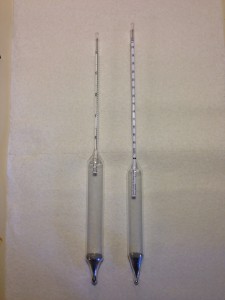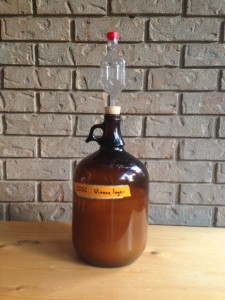
Getting to a respectable final gravity following a stuck fermentation may be easy, or it can be a real pain.
If your fermentation is stuck, you can sometimes remedy the situation. Depending on the problem, this fix may be fairly simple or more involved. In every case, your first step should be to try to rouse the yeast.
Yeast can flocculate (drop out of solution) suddenly for a variety of reasons, including low temperatures, lack of nutrients or a stressful fermentation. A stressful fermentation frequently results when too few yeast are pitched to a high-gravity wort. Sometimes, however, all it takes is stirring them back into solution to restart the fermentation. This is sometimes called rousing the yeast.
Rousing the Yeast
To rouse your yeast, sanitize a long brewing spoon, racking cane or any utensil that can reach to the bottom of your fermenter. Open the fermenter and stir until the sediment on the bottom is at least temporarily back in solution. Try to stir as quietly as possible, as you don’t want to aerate the wort at this point unless the fermentation stuck before moving more than 1/3 of the way through it’s apparent attenuation range. [For example, if you had an OG 1.080 old ale that you expected to finish at FG 1.020, it would pass through 60 “gravity points” as the beer fermented. If the beer stuck above 1.060 (less than 20 “gravity points” or 1/3 of the way through), aerating it would likely help.]However, aeration after fermentation has started causes diacetyl to form.If you aerate as part of your plan to unstick a fermentation, you’ll have leave the beer on the yeast for a few days, or maybe longer, when fermentation was complete for the diacetyl to be reduced.
If your fermenter was cool — and especially if the temperature was below the recommended fermentation temperature range for the yeast strain — let the fermenter warm up to the high end of the yeast’s temperature range before rousing the yeast. Even if the fermentation was in the low end of the recommended temperature range, warming it up is a good idea when attempting to rouse your yeast. If something went wrong with your fermentation, you want to give the yeast every opportunity to recover.
If you suspect that a nutrient deficiency may have caused the problem, for example if you brewed a big Belgian-style beer that included lots of sugar in the kettle, adding nutrients would likely help. However, as with aeration, don’t do this if the beer is more than 1/3 of the way through it’s attenuation range. Excess nutrients left over after fermentation can feed contaminants and lead to beer with sour or other off flavors.
Raising the temperature and rousing the yeast — and perhaps adding oxygen or nutrients — is sometimes all that is required. If you keep the fermentation temperature up, many times the fermentation will eventually finish at a reasonable final gravity (although don’t expect higher-than-average attenuation).
Adding Fresh Yeast
Many times, a stuck fermentation is due to pitching a less than adequate amount of yeast to a high-gravity wort. In this case, adding fresh yeast when the fermenter is warmed and the existing yeast are roused may help. Make a small yeast starter either with the yeast you were using, or any relatively neutral strain that is considered a strong fermenter. In the past, many people would recommend adding Champagne yeast to a stuck fermentation. However, few people have reported good luck with this and sticking with beer yeast for a beer fermentation is likely to yield better results.
The size of your yeast starter depends on how far the fermentation progressed. If your FG is only a few points high, even a small (~ 500 mL) yeast starter — pitched from only a portion of the yeast in a Wyeast or White Labs pack — may do the trick. On the other hand, if your yeast conked out almost right away, making a full-sized starter would be better. You can also use dried yeast to pitch to a stuck fermentation. If you do, it’s best to rehydrate them before pitching.
Sometimes, even adding active yeast to a stuck fermentation doesn’t help. When yeast are stressed, they secrete certain proteins into their surroundings. When other yeast cells encounter these proteins, they go dormant as the proteins are a signal that the environment isn’t conducive to growth. So, in some cases, the freshly-added yeast will simply go dormant when pitched. (Or maybe they will move the fermentation along by a couple points and then conk out). At this point, you have two options — punt or go for a Hail Mary.
Rescuing a Stressed Fermentation
Pouring a batch down the drain is always a bummer — and should always be a last resort. On the other hand, sometimes it’s just easier to start over. In the case of a beer fermentation that won’t restart — even when fresh, active yeast is repitched — you have one last option, but it’s almost as much work as starting over and rebrewing the beer. The last option is fining the beer to remove the stress proteins. You can fine the beer and repitch yet another fresh, active dose of yeast and hope the fermentation reawakens. Silica gel is a fining agent that brewers use to fine for proteins; Bentonite — favored by winemakers for protein fining — may also work. To fine the beer, just follow the manufacturers dosage recommendations and make your slurry of silica gel. Rack the stuck beer to a sanitized fermentation bucket, leaving behind the old yeast, and stir in the silica gel. Once it has sedimented out, rack the beer back to a clean, sanitized fermenter and pitch fresh, active yeast. This is a lot of effort, but it should work. Even if it does, however, your beer may lack in head retention from the lowered protein levels.
Beano
One last possibility to rescue a stuck fermentation is Beano, the digestive aid that lets you eat beans without getting gas. The active ingredient in Beano is an enzyme (alpha-galactosidase) that degrades certain carbohydrates into simpler sugars. In fermenting beer it can turn some unfermentable carbohydrates into sugars that the yeast can consume.
So if your stuck fermentation is a result of exceedingly low wort fermentability, adding Beano (2–4 tablets per 5 gallons/19 L) can help. Keep in mind, however, Beano is unpredictable. It can work well some times and others it will keep digesting unfermentable carbohydrates until they are almost gone and the FG of your batch dips very low. If this happens in a big beer, it can turn into “rocket fuel” — exceedingly dry and with a “hot” alcoholic edge.
Most of the time, however, low wort fermentability is not the problem with a stuck fermentation. Adding Beano may free up some simple sugars that yeast take in more freely than maltose, but it’s not the best cure for most stuck fermentations.
Conclusion
As I said in the first article, preventing a stuck fermentation is preferable to having to remedy it. The most frequent cause of a stuck homebrew fermentation is not pitching enough yeast when making a big beer. Making an appropriately-sized yeast starter takes less time than trying to make up for a lack of it later.
If you enjoy Beer & Wine Journal, please consider supporting us by purchasing my book — “Home Brew Recipe Bible,” by Chris Colby (2016, Page Street Publishing). It is available from Amazon and Barnes & Noble. You can also find the nearest independent bookstore that sells it on Indiebound.


“When yeast are stressed, they secrete certain proteins into their surroundings. When other yeast cells encounter these proteins, they go dormant as the proteins are a signal that the environment isn’t conducive to growth”
This is a most interesting snippet of information. Is there any reference for this proposition or any information on the nature of the proteins that are secreted when the yeast is stressed?